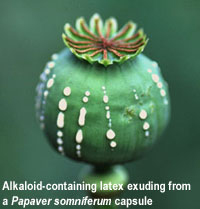
| PLANT
PHYSIOLOGY |
Dr. H Sze |
|
FALL 2008
|
Lecture
# 29 Outline: Secondary products |
[Slides] [Purple tomato] |
Plants are some of nature's best chemists.
Alkaloids- Regulation of opium biosynthesis
Ref.
Taiz & Zeiger 2006, ch. 13. Plant defenses: secondary metabolites.
pp. 316. Get concepts.
Brownstein, MJ 1993. Brief history of opiates. Proc. Nat Acad Sci 90,
5391- 93
*Facchini and de Luca 1995. Phloem specific expression of Tyr/DOPA
decarboxylase genes in opium poppy. Plant cell 7; 1811
Facchini et al. (1998) Regulation of TYDC promoters. Plant Physiol.
118, 69 (online journal)
Hashimoto & Yamada (1994) Alkaloid biogenesis. Annu Rev Plant Physiol
Plant mol Biol. 44, 257
*Kutchan 1995. Alkaloid Biosynthesis-The basis for metabolic engineering
of medicinal plants. Plant Cell 7, 1059-70
*Facchini 2001. Alkaloid biosynthesis in plants. Ann Rev
Plant Physiol Plant Mol Biol 52, 29-66 (online journal)
Outline:
Secondary metabolites are naturally occurring products that do not appear
to affect growth and development.
Physiological significance: They are used by organism for defense against
herbivores and pathogens, and as attractants of pollinators.
Three principle groups of secondary products are
1. Nitrogen containing compounds: include alkaloids.
These are synthesized from amino acids
2. Terpenoids: Some are synthesized from acetyl CoA
3. Phenolic compounds: These are synthesized from
PEP and erythrose via the Shikimic Acid pathway.
These compounds are synthesized from primary metabolites.
History and Uses of alkaloids
Opium was used as medicine; it was effective against
many diseases.
Biosynthesis of opiates in opium poppy:
Where and how are the alkaloids synthesized? From amino acids, tyr
What regulates the synthesis and the enzyme activities? Not much
is known.
Recent research progress from Facchini et al.
Tyrosine decarboxylase (TYDC) is the first enzyme
that leads to synthesis of morphine, codeine and other alkaloids from the
amino acid, tyrosine.
Opium poppy has at least 15 genes encoding TYDC.
Expression of some are organ specific.
TYDC RNA is abundant in the phloem of roots and stems.
TYDC RNA is very low in carpel and undetectable
in capsules,
Morphine levels are high in roots, stem, leaf and capsule. Thus
morphine must be synthesized in the root and stem and then translocated
to the capsule.
Role: defense
Production of alkaloids by biotechnology

Fig. 1. From website of T. Kutchan
Institute of Plant Biochemistry Halle (Saale)
- Germany
... Toni Kutchan Head of Department Natural
Product Biotechnology Abteilungsleiterin
Naturstoff-Biotechnologie Head of the Research
Group "Alkaloid Biosynthesis ...
www.ipb-halle.de/english/institute/research/kutchan/kutchan.htm